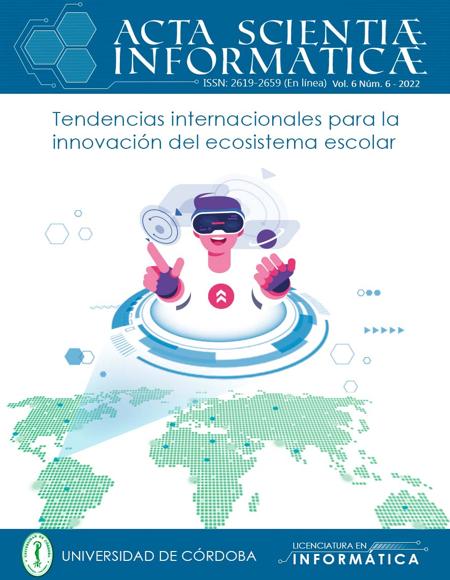Show authors biography
Education must evolve along with technology and the new educational needs it faces [1], this is achieved by innovating in different practices, methodologies and approaches to the development of knowledge, know-how and know-how to be. It is in the search to satisfy this need that initiatives such as STEM are born.
This article, the result of a monograph, presents different conceptions of various authors about STEM and considers the characteristic elements, the typology, the competencies it develops and some significant experiences that have gradually nurtured what we know today as STEM education.
Article visits 441 | PDF visits
Downloads
- M. Paredes, “El aprendizaje activo, el aprendizaje basado en proyectos y la educación STEM,” Universidades los Andes, p. 26, 2018, [Online]. Available: http://funes.uniandes.edu.co/11766/.
- J. P. S. Aguirre., V. del C. C. Vaca, and M. C. Vaca, “Educación Steam: entrada a la sociedad del conocimiento Steam education: entrance to the knowledge society,” vol. 3, pp. 212–227, 2019, doi: 10.33262/cienciadigital.v3i3.4..847.
- O. Nina, “Economía para el Bienestar,” 2020. [Online]. Available: https://inesad.edu.bo/dslm/category/epb/.
- I. Pastor, “Análisis de la metodología STEM a través de la percepción docente,” pp. 1–105, 2018, [Online]. Available: http://uvadoc.uva.es/handle/10324/30952.
- D. J. S. Álvarez, “Editorial Las Stem Como Estrategia Para Fortalecer La Ciencia Y,” Compart. PALABRA Maest., pp. 2015–2016, 2016.
- Pascual, “Stem to Girl,” 2016. https://tecnologiaparaescuelas.com/tecnoedu/home/blog/8-stream.
- T. Zamorano Escalona, Y. G. Cartagena, and D. Reyes González, “Educación para el sujeto del siglo XXI: principales características del enfoque STEAM desde la mirada educacional 1,” 2017. [Online]. Available: https://www.researchgate.net/publication/333824724_Educacion_para_el_sujeto_del_siglo_XXI_principales_caracteristicas_del_enfoque_STEAM_desde_la_mirada_educacional.
- D. Reyes-González, “Educación para el sujeto del siglo XXI: principales características del enfoque STEAM desde la mirada educacional,” 2019.
- V. García, “Innovar en docencia universitaria: algunos enfoques pedagógicos,” InterSedes Rev. las Sedes Reg., vol. XV, no. 31, pp. 51–68, 2014.
- D. Herro, C. Quigley, J. Andrews, and G. Delacruz, “Co-Measure: developing an assessment for student collaboration in STEAM activities,” Int. J. STEM Educ., vol. 4, no. 1, 2017, doi: 10.1186/s40594-017-0094-z.
- G. Yakman, “ST∑@M Education: an overview of creating a model of integrative education,” PATT-17 PATT-19 Proc., no. February 2008, pp. 335–358, 2008, [Online]. Available: https://www.iteea.org/File.aspx?id=86752&v=75ab076a.
- H. Jho, O. Hong, and J. Song, “An analysis of STEM/STEAM teacher education in Korea with a case study of two schools from a community of practice perspective,” Eurasia J. Math. Sci. Technol. Educ., vol. 12, no. 7, pp. 1843–1862, 2016, doi: 10.12973/eurasia.2016.1538a.
- E. Sánchez Ludeña, “La educación STEAM y la cultura «maker»,” Padres y Maest. / J. Parents Teach., no. 379, pp. 45–51, 2019, doi: 10.14422/pym.i379.y2019.008.
- NextBrain, “STREAM , la evolución de STEM y STEAM,” p. 2018, 2018.
- TechnoInventors.inc, “EDUCACIÓN STREAM,” 2020, [Online]. Available: https://estream.school/educacion-stream/.
- R. Roig-Vila, Tecnología, innovación e investigación en los procesos de enseñanza- aprendizaje, vol. 1°a Edición. 2016.
- R. Affifi, “Between Will and Wildness in STEAM Education,” 2020, doi: 10.1163/9789004421585_006.
- C. Alberto, Á. Ruiz, C. Abraham, L. Angélica, G. B. Rojas, and C. A. Lincoln, “ARTÍCULO DE EXPERIENCIA EN EL AULA Educación STEM una ruta hacia la innovación,” 2018.
- M. Caplan and W. A. Segura, “Usando tecnología de videoconferencia para promover la educación en STEM/STEAM en Latinoamérica –Experiencias concretas,” 2019.
- G. Yakman and H. Lee, “Exploring the Exemplary STEAM Education in the U.S. as a Practical Educational Framework for Korea,” J. Korean Assoc. Sci. Educ., vol. 32, no. 6, pp. 1072–1086, 2012, doi: 10.14697/jkase.2012.32.6.1072.
- L. Ruiz and H. Pacheco, “‘Las competencias STEAM como estrategia para alcanzar la formación integral del estudiante de medicina,’” 2018.
- C. Ferrada Ferrada, D. Díaz-Levicoy, F. J. Carrillo Rosúa, and N. Salgado-Orellana, “Cambio de actitud en ciencia y matemática desde la educación STE(A)M,” no. June, 2019, [Online]. Available: http://hdl.handle.net/10481/56108.
- A. Avendaño, “Módulo Stem Dirigido a ESTUDIANTES DE BÁSICA SECUNDARIA,” 2014, [Online]. Available: https://repositorio.uniandes.edu.co/bitstream/handle/1992/17048/u703423.pdf?sequence=1.
- B. K. Tsurusaki, C. Tzou, L. D. C. Conner, and M. Guthrie, “5th - 7th Grade Girls’ Conceptions of Creativity: Implications for STEAM Education,” Creat. Educ., vol. 08, no. 02, pp. 255–271, 2017, doi: 10.4236/ce.2017.82020.
- M. Pelejero De Juan, “Educacion STEM, ABP y aprendizaje coopetativo en Tecnologiaa en 2 ESO.,” p. 83, 2018, [Online]. Available: https://reunir.unir.net/bitstream/handle/123456789/6838/PELEJERO DE JUAN MARTA.pdf?sequence=1&isAllowed=y.
- L. Castillo and W. O. Hachen, “ROBÓTICA EDUCATIVA UTILIZANDO MÉTODO STEAM CON ARDUINO Y IMPRESIÓN 3D,” 2019.
- D. Higuera Sierra, “Implementando las metodologías STEAM y ABP en la enseñanza de la física por medio de Arduino,” III Congr. Int. en Intel. Ambient. Ing. Softw. y Salud Electrónica y Móvil, 2019.
- G. Croce and E. Ghignoni, “The evolution of wage gaps between STEM and non-STEM graduates in a technological following economy,” 2019, doi: 10.1080/00036846.2019.1691142.
- L. Cilleruelo and A. Zubiaga, “Una aproximación a la Educación STEAM. Prácticas educativas en la encrucijada arte, ciencia y tecnología,” Augustozubiaga.Com, pp. 1–18, 2014, [Online]. Available: http://www.augustozubiaga.com/site/wp-content/uploads/2014/11/STEM-TO-STEAM.pdf.
- K. W. Guyotte, N. W. Sochacka, T. E. Costantino, and N. N. Kellam, “Collaborative Creativity in STEAM: Narratives of Art Education Students’ Experiences in Transdisciplinary Space,” vol. 16, 2015.
- NFS, “ESTUDIO SOBRE LAS DEMANDA DE TRABAJO EN STEAM,” NATIONAL SCIENCE FOUNDATION, 2018. https://www.nsf.gov/nsb/sei/edTool/data/workforce-01.html (accessed Mar. 02, 2020).
- World Economic Forum, The Global Competitiveness Report 2016–2017, vol. 21, no. 3. 2016.
- A.C MovimientoSTEM, “STEM,” 2020. https://www.movimientostem.org.
- J. M. Diego-Matecón et al., “DESARROLLO DE CINCO ACTIVIDADES STEAM CON FORMATO KIKS,” 2017.


